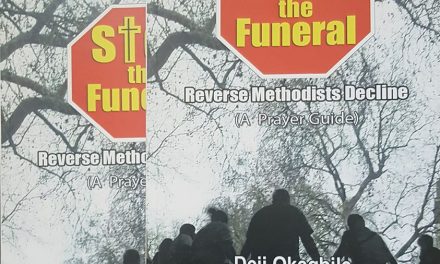“While Jesus was on the way to Jerusalem, He was passing between Samaria and Galilee. As He entered a village, He was met by ten lepers who stood at a distance; and they raised their voices and called out, “Jesus, Master, have mercy on us!” When He saw them, He said to them, “Go and show yourselves to the priests.” And as they went, they were healed and made clean. One of them, when he saw that he was healed, turned back, glorifying and praising and honouring God with a loud voice; and he lay face downward at Jesus’ feet, thanking Him. He was a Samaritan. Then Jesus asked, “Were not ten cleansed? Where are the other nine? Was there no one found to return and to give thanks and praise to God, except this foreigner” Jesus said to him, “Get up and go. Your faith has restored you to health” – Lk 17:11-19.
The missional connection to the reading from the Gospel of Luke, chapter 17, about Jesus’ journey to Jerusalem when he hears the distant voices of ten lepers crying out, “Jesus, Master! Have pity on us,” speaks to what I call the 21st-century Council of ten lepers. (Lk 17:11-19). The central message of Scripture is the unchanging Gospel of salvation through Jesus Christ alone, and that remains the common need of the 21st-century Council of Ten Lepers, just as it was 2,000 years ago. In historic Christianity, those who minister, whether from the pulpit or on the worship platform, were not just any leper, for we are all lepers with some degree of faith, but the ‘one leper’ who holds to high biblical standards, exemplified holiness, repentance, theology and a lifestyle consistent with Christ’s teachings.
The 21st Century Council of ten lepers is about the state of the Church and its leadership, having a form of religion without repentance and power. The secret to the Church’s and leadership’s power is not titles, degrees, hierarchies, or status, but repentance. Repentance and holiness are fundamental to Christian faith, genuine discipleship and church discipline. A missional Church Council is primarily designed to address unrepentant sin and promote a return to righteousness.
Jesus healed the ten lepers from a distance. Beloved, do not be a distant Christian; Jesus called you to be His disciple, a relational engagement. Distance Christianity is deceitful, declining, destructive, and defective discipleship, a fading encounter shaped by a dangerous, immoral obsession and perspectives. The Bible says, “Peter followed at a distance,” hence his lukewarm commitment and a compromise where commitment is not total (Matt 26, Mk 14:54). Like many of us, we may not have been too far behind Jesus physically, but spiritually, like Peter, we are at a great distance. Peter denied even knowing Jesus, like many churches, following Jesus at a distance, shying away from the name and teachings of Jesus Christ.
Distance Christianity is a state of being halfway between following Jesus and the world. The primary danger of distance Christianity is falling into sin under pressure. Peter’s denial of Jesus is a prime example of how distance from Christ can lead to completely disowning Him, even to the point of denying Him with oaths and profanity. One of the reasons behind Distance Christianity is the prioritisation of comfort and safety. Peter distanced himself to stay warm and safe, a decision driven by a desire for comfort rather than standing with Jesus. Many messages warn against this, reminding people that following Jesus is not about comfort but about character and transformation. Distance Christianity is a distorted perspective of life and God’s plan. When a person is far from God, they become vulnerable to sin.
In the story of the ten lepers, the Gospel says, “When he saw them (in a distance), he said, ‘Go show yourselves to the priest” (Lk 17). The instruction given to the ten lepers to go and show themselves to get a bill of clean health speaks volumes about the application of leprosy, not just a disease of the skin, but as a sign of sin. The reflection is, what is the reason behind the actions of the leper who returned and “fell at the feet of Jesus and thanked him.” St Augustine, on how a true follower of the Church acts, writes. “Whoever then follows true and sound doctrine in the fellowship of the Church, proclaiming himself to be free from the confusion of lies, as it were from leprosy, yet still ungrateful to his Cleanser does not prostrate himself with pious humility of thanksgiving, is like to those of whom St. Paul says, ‘though they knew God, they did not honour him as God or give thanks to him'” (Rom 1:21).
On their way to the priest, the ten lepers were healed. When we walk by faith, we can experience God’s power in our lives. “As they went, they were healed.” As we go by faith, we can also be healed. Beyond the teaching on the need to be grateful for the cleansing and healing encounters for the ten lepers, the story provides hope for church and leadership renewal and revival. The reflection is that, today, beyond the physical illness of leprosy that separates people from God, sin, spiritual and moral evil separate us from God. The leprosy of sin that is ravaging the Church and the leadership today goes beyond a priest’s approval or recommendation. Except the Lord build the house, they that labour labour in vain. Except we receive the mercy of Jesus Christ for the forgiveness of our sins, the arms of flesh – activities of any priest, bishop, or pope amount to vanity.
Leprous nations or churches are incapable of engaging in an effective act of worship and evangelism. A leprous priest produces a leprous church, hierarchy and institutions. A priest, beyond a professional job, but as a calling and vocation, examines and speaks to the people and nations through the telescope and lens of the Gospel. Stewardship without salvation declines the Church. Until we all humble ourselves and fall at the feet of Jesus Christ as our Lord and Saviour, our priestly and leadership actions amount to a broken cistern pot that holds no water.
The 21st Century Council of Ten lepers suggests a Church Council and Committee with differing theologies, lifestyles, and debates where democracy is at play – nine lepers’ voices override one leper’s voice. The ten lepers, banded together by the church Council’s responsibilities and positions, are caught between loyalty to Jesus and the priest, the church institution. It is the tragedy of the leprosy of sin that united the ten lepers in a common need for healing; they called on Jesus to do. Once healed, they went their separate ways. Revival and renewal are delayed in our churches and nations because the 21st-century Council of ten lepers, who manage the Church, are united by need but separated by salvation in Jesus Christ.
The Bible says that one leper returned. Why only one leper? What was different about this one leper and the nine lepers? The difference between the nine lepers and the one leper is that: “In the heart of the one… something was born that was not born in the hearts of the others, something that drew him back to Jesus despite the decision of the nine to go on, something that could not draw the others… because they grasped only at the healing, and not also at the Healer.”
The one leper, a Samaritan, came to Jesus and fell at His feet with a spirit of thankfulness. Jesus’ response to the Samaritan leper offers a renewing reflection for the lepers of the 21st century. Jesus asks, “Were there not ten cleansed? However, where are the nine?” Jesus continues, “Were there not any found who returned to give glory to God except this foreigner?” Jesus’ words, “Where are the other nine?” convict the lepers of the 21st century of the need to return to Jesus Christ in repentance, rather than being busy with other things in life.
In contrast, Jesus gave His word of assurance to the Samaritan – one leper, “Arise, go your way. Your faith has made you well” All the lepers had some degree of faith to begin the journey prior to their healing. However, only the Samaritan leper had saving faith, which produces not only thankfulness but repentance. The nine lepers’ lack of repentance, that is, returning to Jesus, was a much worse form of leprosy of sin than the leprosy of skin.
The 21st Century Council of the Ten lepers comprise two groups, pointing to the foundation and the bane of the spiritual and leadership crisis and church decline. The first group consists of the nine lepers, who represent churches and leaders that receive God’s blessings but fail to acknowledge Him as their Lord and Saviour, leading to a decline in faith. The nine lepers are not only spiritually complacent, but they are also ‘lost in religion’ with a focus on formalism without genuine repentance. The nine lepers mirror the corrupt, unfaithful, and ungrateful symbol of hierarchy and democracy that not only defiled the altar but also declined the Church. Through the lens of the nine lepers, the words of the Gospel go in one ear and out the other simply because they have not met Jesus Christ.
The second group of the 21st-century Council of ten lepers is the one leper, a mission and truth compass of a church or individual who has returned (a turning around – repentance) to give thanks to Jesus Christ. The one leper is not just a pointer to the repentance and renewal needed within the Church and salvation found only in Jesus Christ; he is an example of pulpit consecration, humility, and sincerity. The one leper embodies holiness, piety, not opulence, and not a cult of greed and corruption, as seen in the Church and the world.
Beloved, which of the groups of the 21st Century Council of Ten lepers are you? The first group of the nine lepers may have been skilled in showmanship, without any genuine spiritual conversion added to the Church. They are just busy but guilty, hence the Church is disconnected from Jesus due to a lack of repentance. The Church, lacking spiritual authority, is becoming an empty building, maintained for the sake of power and privilege, rather than a movement of holy people. Luke says that the Samaritan leper, the second group of ‘one leper,’ returned glorifying God with a loud voice. I wonder if the sound is like singing the hymn by Eliza Edmunds Hewitt, simply saying,
1. My faith has found a resting place,
Not in device nor creed.
I trust the ever-living One;
His wounds for me shall plead.
Refrain:
I need no other argument,
I need no other plea,
It is enough that Jesus died,
And that he died for me.
2. Enough for me that Jesus saves,
This ends my fear and doubt;
A sinful soul I come to Him,
He’ll never cast me out. [Refrain]
3. My heart is leaning on the Word,
The written Word of God,
Salvation by my Savior’s name,
Salvation thro’ his blood. [Refrain]
4. My Great Physician heals the sick,
The lost He came to save;
For me his precious blood he shed,
For me his life he gave. [Refrain]











Recent Comments